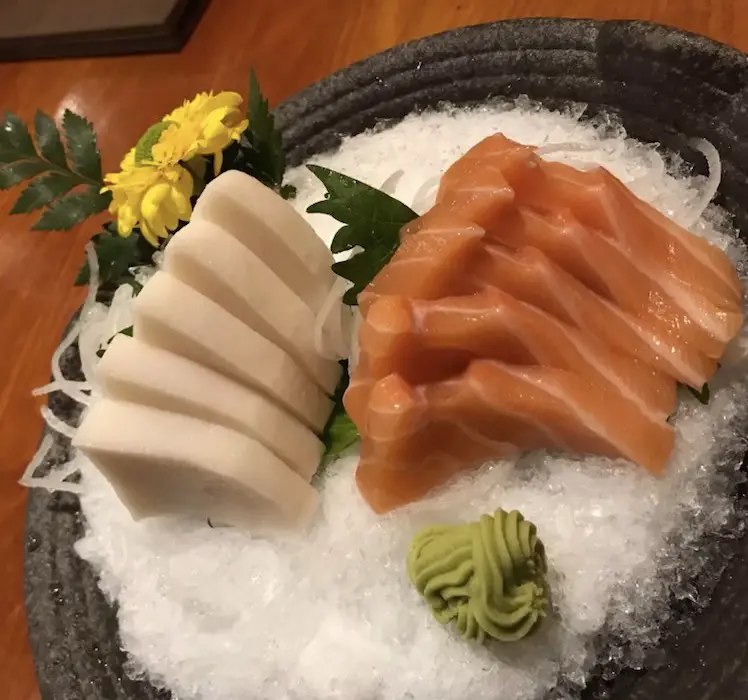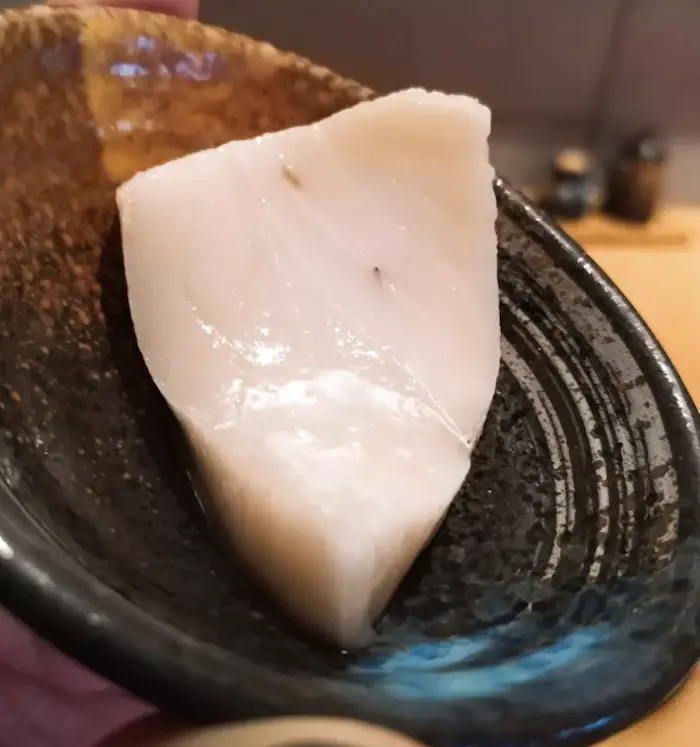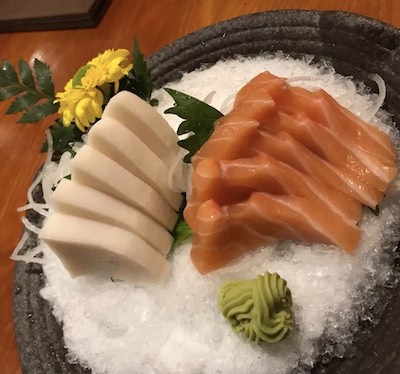We are reader supported. When you purchase through links on our site, we may earn an affiliate commission. Also, as an Amazon affiliate, we earn from qualifying purchases.

Have you ever walked into a sushi restaurant and found the terms ‘white tuna’ or ‘white maguro’ written on the menu? If that makes you feel that the restaurant is offering you high quality and delicious fish at a reasonable price, I don’t blame you. It’s supposed to make you feel that way but read on to find out the truth.
What is white tuna? I hate to spill the beans but it’s true that there is no such thing as white tuna. No, you are not getting chutoro or otoro at a bargain price. White tuna is the misleading nickname given to flesh from two main fish species – Albacore and Escolar (also known as oilfish or butterfish for its high butter content).
The reason why ‘white tuna’ appeals so much to customers and restaurants also take full liberty at promoting these items is that it tastes much like the richly textured fatty tuna. The buttery texture of the meat gives an impression to diners that they have a flavorful alternative of the expensive options on their plate.
Escolar – The Delicious And Buttery Fish On Your Plate
Also known as oilfish, waloo, or butterfish, escolar is a type of snake mackerel species that is often served as king tuna or super white tuna. The fish belongs to the Gempylidae family and it is found in the tropical and temperate waters across the world.
While several fish species are in danger of overfishing and other species becoming undesirable due to high mercury levels, many seafood fans prefer this fish that is cheap, sustainable, delicious and low in mercury content.
The rich buttery texture of escolar comes from the wax esters in its diet. As the fish cannot metabolize the waxy substance, the meat becomes buttery. Now, esters are similar to castor oil in thickness and if someone consumes a full portion of an escolar, it may cause gastrointestinal symptoms.
Interestingly, the Italian and Japanese governments have banned the sale and import of escolar on health grounds. In Denmark, Canada, and Sweden, they must come with warning labels. In the US, there is no such restriction. As a result, escolar fish is widely used as white tuna in US restaurants.
Reference: https://www.nytimes.com/1999/03/10/dining/eating-well-a-fish-puts-chefs-in-a-quandary.html
Albacore – The Palest Tuna With Mildest Flavor
The albacore is a species belonging to the tuna family and it is called longfin tuna. It is mostly found in the tropical and temperate waters around the world. Also known as the canned white tuna, this is a common variety of tuna and mostly found in large pale pink chunks.
Albacore tuna can be identified by their long pectoral fins that cover 30% of their bullet-shaped body. They are typically smaller in size than other species like yellowfins and skipjack. They usually have a dark-blue back, and lighter blue to grayish sides and belly portion.
Albacore tuna serves as a nice ingredient for appetizers, salads, or sushi. In many restaurants, escolar fish is passed off as tuna, which is not ethical. Here are a few things that can help you differentiate between the two:
Price is an important indicator. If the fish meat is derived from tuna then it will typically have a high price tag. If you see someone selling tuna for $12 per pound then this is a red flag. Don’t opt for the cheaper option when buying raw fish because you will end up paying in another way.
Color of the meat is another giveaway because tuna fish is never purely white in color. It can be pale but will still have a pinkish hue. If the flesh is white then it is escolar by all means. Tuna also has some opaqueness that you will not find with escolar.
Try to find out the origin of the fish by asking questions to the fishmonger. Ask him when the fish was caught and if it was frozen. If the seller hesitates to answer then walk away. If a fish is frozen, it is not a bad thing because many fishermen freeze the fish as soon as they are out of water.
Albacore vs Escolar: White Tuna Explained
While there are many fish varieties that may be labeled as ‘white tuna’ at a sushi bar that doesn’t care about customers’ sentiments, the two most common are Albacore and Escolar. While Escolar is often passed as super white tuna, other fish species that may fall under white tuna are black marlin, sura, porbeagle, and thin-tail thresher shark.
If you put chunks of Albacore and Escolar side by side, you can tell the obvious difference in color. While the Escolar chunk looks white, Albacore is more on the pale side or light pink. On the outer front, you can see that escolar is more shimmery and opaque, while albacore is translucent in appearance.
So, the two options here are – a tuna fish that is pale pink, not white; and a fish with white meat that is not tuna for sure. If I had to choose, I would go with Super White Tuna that has high-fat content and makes each bite sublime. Albacore has a subtle taste, which is similar to tuna fish you can find at any sushi joint.

One of the biggest challenges is to identify the type of fish served to you. The super white tuna is Escolar but that does not mean that white tuna is Albacore. There are many species of fish that look similar to these two. I would suggest that you ask questions regarding the species of fish offered to you.
Difference Between Light Tuna And White Tuna
Tuna is a huge fish and beginners may have some trouble understanding the different varieties of flesh derived from tuna fish. They may also differ based on the regions where they are caught. Most people buy whatever is available with the fishmonger, however, it’s worth noting that they differ widely in terms of nutrients, taste, and how to use them.
When you know the differences, it will help you buy the perfect slice of meat for making sushi or other delicacies. Being informed about what you buy can also help you plan healthy meals for the family. So, if you have heard about white tuna, do not confuse it with light tuna. Here’s the difference between the two.
Light tuna is typically the meat derived from the tuna species that fall under the ‘light category’ and these are Yellowfin tuna or Skipjack. The color of the meat is somewhere between light tan and light pinkish.
The texture of light tuna meat is softer and it is also more flavorful than white tuna. Some people feel the texture is similar to chicken’s thigh. If you purchase light tuna from a fishmonger, you will usually get a chunk piece cut from the loin region. In terms of nutrition, light tuna is comparatively lower in fat than white tuna.
The Albacore (nicknamed as white tuna) is a fish species that has pale white to light pink colored meat. It has a firm and fair texture with a mild fish flavor. Some people compare the taste of slightly baked chicken breast with a mild flavor. It may be sold as tuna fillets at the fishmonger or available as chunks similar to light tuna.
Eating White Tuna And Staying Safe
According to Oceana’s research, about 84 percent of ‘white tuna’ fish samples done in the US was escolar. The label ‘white tuna’ itself is a cause for alarm because there are no such fish species. The lightest color of meat in the tuna family belongs to Albacore. The meat of Yellowfin, Bluefin, and Ahi are comparatively darker.
Mislabeling of fish is a common occurrence in sushi restaurants across the US. About 74 percent of sushi restaurants and 18 percent of grocery stores were found guilty of mislabeling fish. So, you need to be careful that you don’t buy escolar thinking it to be Albacore.
Despite all the information mentioned above, it cannot be denied that escolar is an extremely delicious fish. The buttery texture makes it sought after and highly preferred by food lovers. If you love this rich and flavorful fish, here are some tips to stay safe.
Whether you consume escolar as sushi or sashimi, let’s assume that one piece takes about .5 oz/1 oz of meat. Count your intake and make sure that you consume less than 6 ounces as portions less than 6 are known to not cause any gastrointestinal distress. Also, always remember to buy only from a reputed fishmonger you know.
If you can’t find a trusted local fishmonger near you, consider buying sushi-grade fish from a trusted online source that labels fish correctly.
Related Question
Is tuna red or white meat
Flesh from tuna fish is typically dark red or pink in color. Albacore tuna is the mildest form of tuna that has a light pinkish hue. There is nothing called white tuna but restaurants in the US use this term to create an impression on diners that they are eating a rich alternative to fatty tuna.
How much calories in albacore tuna?
When albacore tuna is canned, it is often called chunk white tuna and a 3-ounce serving contains about 109 calories and 3 grams fat. When canned in oil, the same amount has about 158 calories and 7 grams fat.

